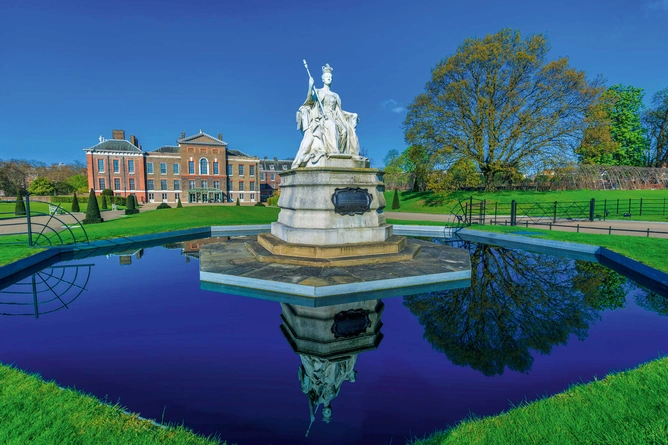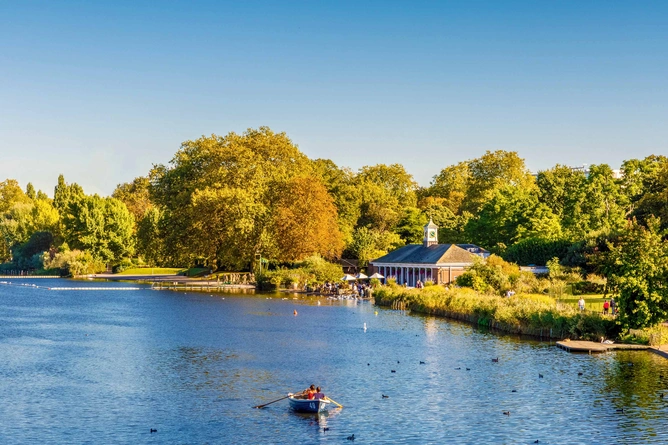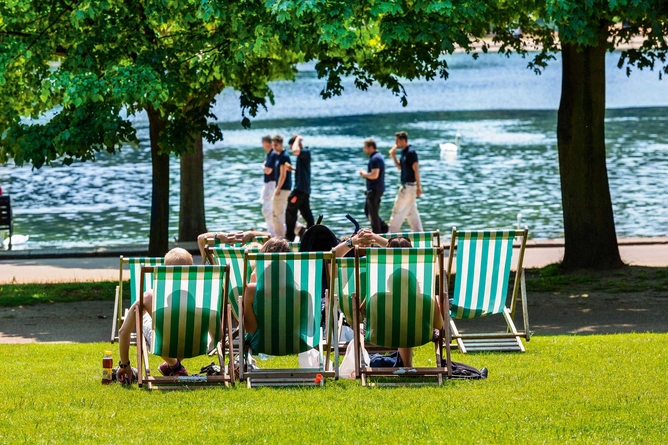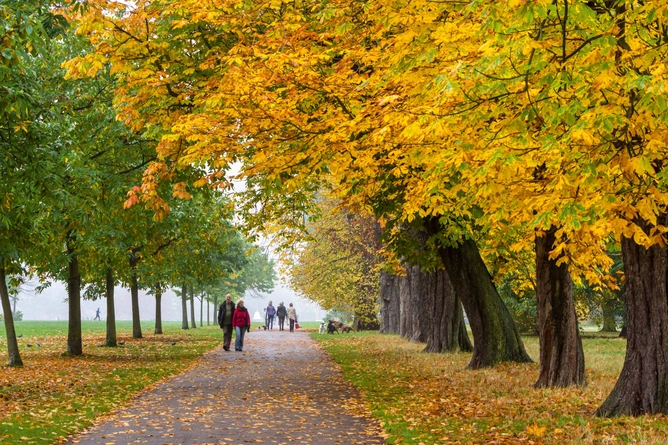Charles Dickens loved “the park, par excellence”. Virginia Woolf, her sister Vanessa Bell and brother Thoby used to publish a little newspaper with all the merry happenings when they lived at 22 Hyde Park Gate, and Michael Holme, that poignant violinist protagonist in Vikram Seth’s haunting love story An Equal Music, lived at Bayswater Road and swam in the Serpentine, its famed lake.
We are talking of course of Hyde Park—350 acres with a long snaking walk around the 40-acre lake called the Serpentine. Here, until the 18th century, deer were hunted by the nobility, and no doubt some merely rich too. After all, the park was created for hunting by Henry VIII in 1536 after he bought the manor of Hyde from the neighbouring Abbey. The Great Fair of 1814—where the Battle of Trafalgar was re-enacted—unfolded in this park, complete with the French fleet sinking dramatically in the pond. The Great Exhibition of 1851 with its giant Crystal Palace took place here. The Irish Republican Army bombed it in 1982, Pope Benedict held his prayer meeting here in 2010 and since 2007, it has hosted a giant Winter Wonderland with the U.K.’s largest outdoor ice-skating rink. It also regularly hosts some of the world’s top musical acts—Bob Dylan stopped by this July.
But Hyde Park has developed another identity—as London has become the capital of global money—over the years. It is home to that unique thing which, having observed it for years, I have termed the Hyde Park Power Walk.
It is a walk that is conducted through the summer by the rich and famous (mostly by the rich), who flock to live around the park.

There are two kinds of clothing to be found on this walk: Western-styled comfort wear or the billowing robes of Arabia that swish in the sunlight as the richest and poshest of all the Gulf states seem to have arrived in central London during Ramzaan season.
For the usual walk, you can stroll in from somewhere right after Harvey Nichols, the poorer cousin of Harrods in the area, cut through the buildings, cross the road and enter the park. Or you can enter from near Wellington Arch at Hyde Park Corner and walk through the track, passing the flower gardens and the Serpentine Bar & Kitchen, onto to the open stretch crisscrossing joggers, skateboarders and walk or jog down the path beside the famous ducks in those famous waters.
What was once a mere stroll through beautiful gardens, stopping at nurseries and for a pint once in a while, has developed in the English summer into a rendezvous for the rich and the powerful. The great advantage, several bankers and wealth managers in London have told me over the years, for a power walk meeting in Hyde Park is the lack of technology. But if that sounds intriguing, allow me to explain. Almost every meeting place in London, public or otherwise, risks being stealthily bugged, surreptitiously recorded, and there is just no saying who would be able to plant what technological surveillance equipment and where.

Ironically, therefore, there is nothing like a park. You can easily be spotted but you cannot easily be recorded. Also, the classic power move at Hyde Park is a meeting held over a walk, not a sit-down meal. This means that the participants are continuously in motion which reduces the chances of any static recording machinery working very well. At an easy pace, the entire walk around Hyde Park could take well over an hour to up to two hours, enough time to conduct any important negotiation in detail. The park also allows a certain distance from the work environments where deals are usually struck, allowing a sense of refreshing space to clear the mind and have out-of-the box conversations that might be impossible in a traditional business setting. The people who have these conversations at Hyde Park are some of the wealthiest people in the world with only two things in common—a love for London in summer and an affection for this sprawling park. These are not people who give interviews about their habits but over the years of visiting Hyde Park and hanging out with people who service this global ultra-rich, I have discovered this fascinating, hidden trait that I have never written about before.
When I first started to go to Hyde Park at the turn of the decade, I noticed that no one wore those uber-expensive sneakers that I used to spot at Central Park in New York City, Air Jordans. At Hyde Park, it was always more understated. What began with simple monotone Nikes metamorphosed to designer leather sneakers by the middle of the decade; for a couple of years in between, it seemed to me that everyone was wearing Gucci sneakers, then it got swiftly balanced by Burberry (London’s homegrown luxury giant)—and last year, it seemed everyone was wearing Allbirds. The merino wool sneakers that had taken over Silicon Valley had swooped into Hyde Park too. But longstanding favourites remain the Gucci Ace Watersnake-Trimmed Embroidered Leather Sneakers and the Burberry Vintage Check Cotton Sneakers. During this time, of course, the few Mackintoshes all converted to Burberry trenches. Among standard accessories to the Hyde Park walk is the often spotted olive shopping bag from Harrods.
The Hyde Park Power Walk is neither fast, nor slow; it is neither swift, nor leisurely, but has a negotiated pace of its own—which depends on who you are walking with. I did a back-of-the-envelope poll with assorted banker and hedge fund friends and here are the findings, if you will, that emerged:
- If you are walking with an Arab sheikh, you walk a pace behind him and pause often to ensure he does not feel that you are hogging the conversation; importantly, if the Arab client is with his family, do not address the family members unless occasion to do so appears and a gesture to do so is provided.
- If you are with American old money, you skip just a wee bit ahead to ensure that you are almost facing him when you speak, and make sure your phone is switched off.
- If you are with an Indian politician or a business tycoon, you usually stop to feed the ducks and keep quiet when he takes phone calls in the middle of the meeting.
- With the Chinese, it’s not much a walk; you come, you pace up and down, he sometimes checks his texts, and it’s over rather quickly.

Some might feel there is a sexist assumption in the above that most of this kind of dealmaking is done by men but everyone I spoke to insisted it was overwhelmingly between men. Also, bodyguards are entitled to do a pat-down before the conversation begins, but bodyguard clothing has significantly evolved over the years to ensure that they do not stand out.
If the conversation continues around the park, a good place to pause is at the memorial of the late Princess Diana—though to carry a Harrods bag to her memorial might be slightly tasteless. (If you didn’t get that, you must try harder to be a Londoner.) Or if you seek more refined surroundings, then a good dealmaking pause is to be found at two galleries—the Serpentine and the Serpentine Sackler—both within the park. Stepping into a gallery, especially at Hyde Park, is a power move itself. In the world of art, the director of the Serpentine Galleries, Hans Ulrich Obrist is often described as a ‘super curator’, one of the most powerful people in the global art bazaar, who regularly tops various lists as the most important and influential curator in the world of art. Depending on your own influence and spending power, you may just be able to wrangle a face-to-face with Obrist himself. If your spending power is significant enough, you get to refer to Obrist by his famous moniker HUO.
I was once walking in Hyde Park with a curator from the V&A museum who was handling some of the greatest jewels in a Gulf state collection of one of the wealthiest royal families of the Arab world. She told me a curious bit of Park etiquette: quite like the London Tube, never make eye contact unless you know the person; often, if not always, wear sunglasses; and it is not the sort of park where one usually pets unknown kids or dogs. About the dogs, you could, of course, have one on a leash, but the truly evolved Londoner has suitably dignified dogs who do not need anything as crude as a leash.

If one stops to feed the ducks, it must be duck pellets, whole wheat or birdseed—never white bread, or cooked food, or meat. Oh, and the swans, the queens of the Serpentine, love lettuce.
The idea of the power walk at Hyde Park is to never give the sense that this is official business or that anything significant or stressful is being conducted. The idea is always to feign a sort of leisurely tonality which eases the deal in place amidst the sylvan surrounds—and, of course, while stringently ensuring that the negotiations go smoothly.
The only real interruption might be someone ranting too loudly once you get to Speakers’ Corner—a free area of anyone wanting to give a speech or conduct a debate and where, once, people like the writers George Orwell and Karl Marx once espoused their ideology enthusiastically. Needless to say, if you are on a power walk, you do not spend too much time at Speakers’ Corner.
The Hyde Park Power Walk is business wheeling and dealing in one of the loveliest urban locales of the world. It has converted one of the most renowned parks in the world into a rendezvous for striking deals. The story of deals in Hyde Park is a wonderful marker, in my mind, of what makes London special among all the financial capitals of the world—a sense of intimacy and cosiness even in a megapolis. Unlike NYC’s intimidating bigness and tallness, London retains at its core an almost deceptive, yet very palpable, sense of neighborhood-y, British understated-ness that makes it a special city.
(This story was originally published in the September 2019 issue of the magazine.)







Leave a Comment
Your email address will not be published. Required field are marked*